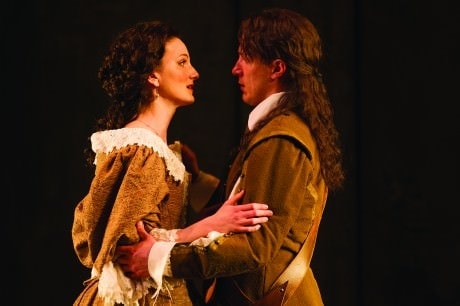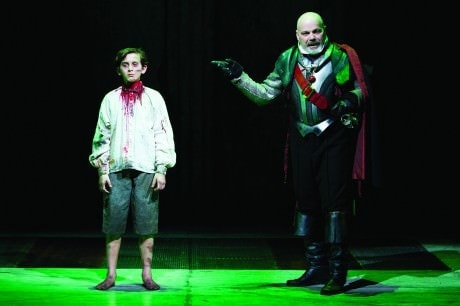In its American premiere, Friedrich Schiller’s Wallenstein by Shakespeare Theatre Company is a tour-de-force, surprisingly funny, sharp, and shattering. It’s paired with their excellent Coriolanus in what they’re calling the ‘Hero/Traitor Repertory.’
Who can take credit for this brilliant production? The playwright, Schiller, deserves a lot for his political savvy, humor, and flair for drama. He’s considered to be ‘The German Shakespeare’ and wrote Wallenstein in 1799. His most famous work though was as a poet. He wrote the words to Ode to Joy. Some of his poetry is recited during the production.

Former Poet Laureate Robert Linsky also deserves credit for this newly commissioned translation and adaptation that does not shy away from parallels and parables to our own 10-year religious, political wars, and our obsession with loyalty and heroes.
Shakespeare Theatre Compnay’s Artistic Director and director of this production Michael Kahn deserves much of the credit for his bold choices and fierce attention to every little detail. Shakespeare Theatre Company won the 2012 Tony for Best Regional Theater and it’s not very hard to see why. Scene changes were effortless. Small exchanges were exploited for every moment of humor or pathos. Every note hit perfectly as he built each actor to the edge and the play to its heartbreaking conclusion.
And of course, everything hinged on Wallenstein himself, Steve Pickering with his brash, fearless, and funny portrayal of the hero…traitor. This is no tortured, self-doubting soul. Wallenstein is brilliant, self-aware, and self-deprecating, and at the top of his game. He approaches his treason with something like glee, but Pickering lets the suave political mask slip at just the right moment to reveal a boundless rage at the price his men have paid. Those moments left me shivering.
The real Wallenstein was the commander of the Imperial Prussian Army during the 30 Years War in the 1600s. The war was fought mostly between Protestants and Catholics in France and what became Germany. Even at the time no one was sure whom or why they were fighting. As Wallenstein says in the first of his many asides to the audience that break both the fourth wall and the time period, “Forget about The 30 Years War. Where I am, nobody thinks about that stuff.” Of course not, when Wallenstein defected, they were only halfway through. But, as he crows, he did get a board game named after him for this brilliant if doomed strategy to try to stop the madness at 15 years.
When the lighting goes green and the cast sways on stage to song or poetry, or when Wallenstein is cracking jokes at himself or his men – it’s jarring but ultimately effective in modernizing him and making some of the more difficult parts of the piece relatable, like Wallenstein’s crediting astrology with his winning strategies.
Often in a play about one charismatic leader, everyone else is around to foil him, but in this play, every character is tested and it was a joy to watch this talented cast take up the reigns.
Wallenstein is goaded into treason by his brother-in-law and his sister, the Count and Countess of Czerny (Michael Santo and Diane D’Aquila). D’Aquila is a force of nature, reveling in her character’s scheming and power. The countess is a modern woman, more blood thirsty and ambitious than even Wallenstein himself. Santo walks the careful balance of his character – subservient to wife and general but with enough self respect to goad both into action. His other co-conspirator, Kolibas (Derrick Lee Weeden) is brash and complicated – flinging himself joyfully into his treason. Weeden is also really funny and does not shy away from exploiting the laughs regardless of the mood of the rest of the scene. The choice works for this character.
The Emperor’s men, who do not follow Wallenstein into treason, are the Italians, Octavio and his son Max Palladini (Robert Sicular and Nick Dillenburg), plus the Emperor’s envoy Questenberg (Philip Goodwin) who is delightfully simpering and sniveling. In a way, Sicular’s performance is as key to the play as Wallenstein himself. He is an equally powerful man who can see the hash the Emperor’s made of the war, yet does not choose treason. They are mirrors and Sicular is a great foil for Pickering. Dillenburg shines as the young, idealist. The honorable man in a nest of vipers can be a challenging part…coming off as preachy or boring…but Dillenburg plays him with heart and humor.
He falls in love with Thekla (Aaryn Kopp), Wallenstein’s daughter, another unusual woman for her time. Kopp plays her strong and smart and the love and respect that grows never falls flat or seems forced.
As it is in reperatory, many actors cover multiple roles across both plays and the ensemble picks up two and three parts even within the play. The disciplined rehearsal it must have taken to mount two such ambitious productions is impressive -especially since much of the action of Wallenstein takes place offstage or at the back of the stage in a room only half-visible to the audience behind the towering stone walls of the set. Sound Designer and Composer Fitz Patton had his hands full to conjure a battle and a huge crowd while the only action on stage is the generals standing around listening to it. It works.
The generals especially do a wonderful job of imbuing each of their characters’ with personality. In a play full of men in breast plates and swords talking war, it could have quickly become both confusing and exhausting, but instead, even that backstage action is engaging. Kudos go to Fight Director Rick Sodelet for the most realistic stage fight I’ve ever seen. It was fast, violent and bloody, far from the usual polite dance of swords.
The costumes by Murell Horton are period with metal helmets and breastplates, capes, and swords. The knee boots with wide cuffs are also fun. The women are dressed in corsets and full skirts.
The set by Blythe R.D. Quinlan divides the stage as I mentioned. Stone walls reach into the lights. Two staircases lead to a second level of alcoves that double as windows or balconies, at some points decked in flags. The center of the marble floor splits seamlessly as tables, chairs, or a bed rise quickly to the surface. Lighting Designer Mark McCullough lights the monochromatic stone beautifully as he drenches it in surreal greens or warm yellows during the more intimate family scenes or bright white or red in the battle.

Is it treason to betray an incompetent King? Was Wallenstein a hero or traitor? This brilliant play explodes that question in a superior production on every level. Wallenstein is a night of smart, entertaining theater, not to be missed.
Running Time: Two hours and 30 minutes, with one 15-minute intermission.
Wallenstein plays through June 2, 2013 at Shakespeare Theater Company’s Sidney Harman Hall – 610 F St NW, in Washington, DC. For tickets, call the box office at (202) 547-1122, or stop by at the Harman Hall box office, or purchase them online.




